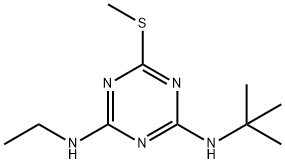Terbutin is a systemic and conductive herbicide, which can be used for pre-emergence and post-emergence weeding, and the effective period in the soil is 3-10 weeks. It is mainly used in winter wheat, barley, sorghum, sunflower, potatoes, peas, soybeans, peanuts and other crop fields to control perennial ryegrass, ryegrass and autumn germinating chickweed, marigolds, poppies, kangaroo, crabgrass, foxtail Wait.
Selective herbicide for control of annual broad-leaved and grass weeds in wheat.
A labelled triazine herbicide.
ChEBI: A methylthio-1,3,5-triazine that is 2-(methylsulfanyl)-1,3,5-triazine substituted by a tert-butylamino and an ethylamino group at positions 2 and 4 respectively.
Cyanuric chloride reacts with ter-butylamine to generate 2,4-dichloro-6-tert-butylamino-1,3,5-triazine; then reacts with ethylamine to generate 2-chloro-4-ethylamino-6-tertiary Butylamino-1,3,5-triazine, and finally reacts with methyl mercaptan to generate Terbutryn.
Plant. In plants, the methylthio group is oxidized to hydroxy derivatives and by
dealkylation of the side chains. Residual activity in soil is limited to approximately 3–10
weeks (Hartley and Kidd, 1987).



